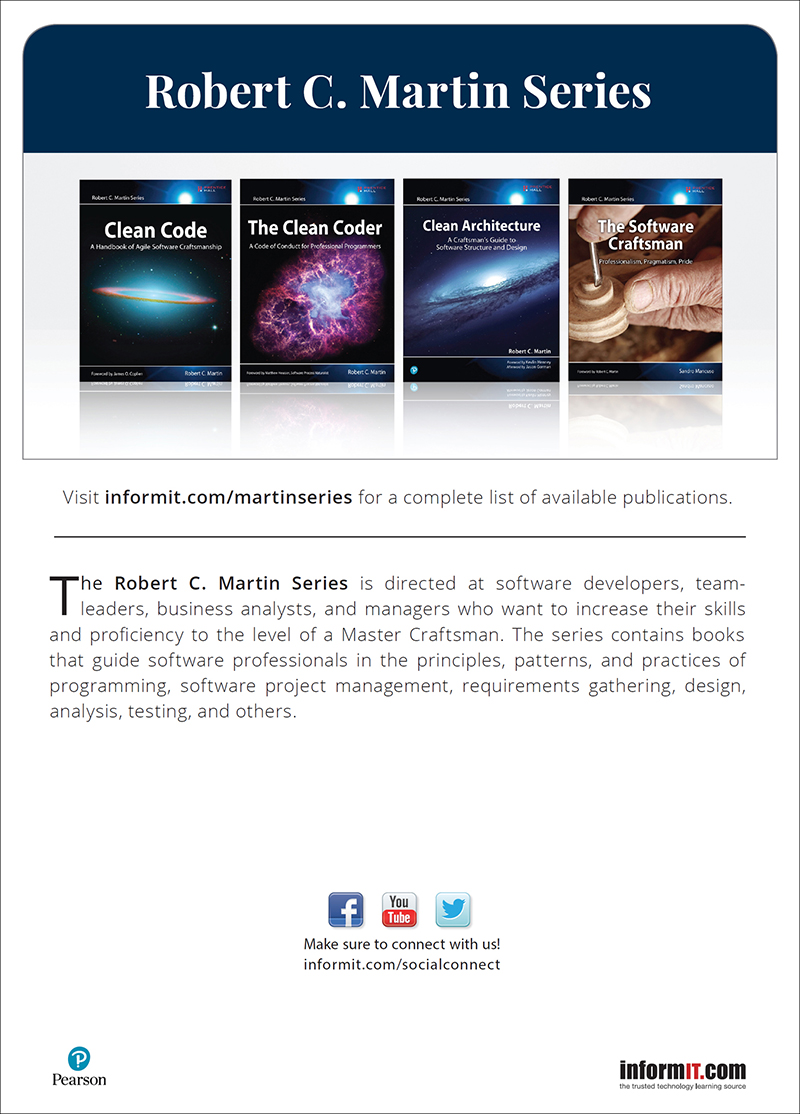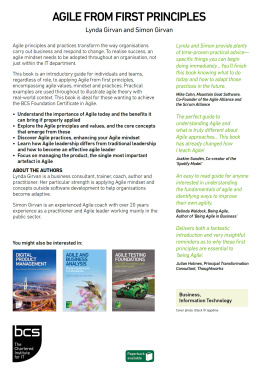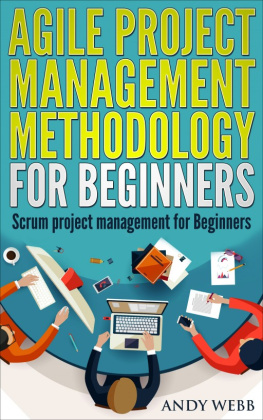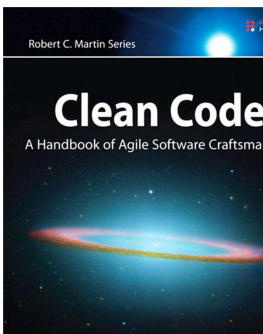Robert C. Martin - Clean agile : back to basics
Here you can read online Robert C. Martin - Clean agile : back to basics full text of the book (entire story) in english for free. Download pdf and epub, get meaning, cover and reviews about this ebook. year: 2020, publisher: Prentice Hall, genre: Romance novel. Description of the work, (preface) as well as reviews are available. Best literature library LitArk.com created for fans of good reading and offers a wide selection of genres:
Romance novel
Science fiction
Adventure
Detective
Science
History
Home and family
Prose
Art
Politics
Computer
Non-fiction
Religion
Business
Children
Humor
Choose a favorite category and find really read worthwhile books. Enjoy immersion in the world of imagination, feel the emotions of the characters or learn something new for yourself, make an fascinating discovery.

- Book:Clean agile : back to basics
- Author:
- Publisher:Prentice Hall
- Genre:
- Year:2020
- Rating:5 / 5
- Favourites:Add to favourites
- Your mark:
- 100
- 1
- 2
- 3
- 4
- 5
Clean agile : back to basics: summary, description and annotation
We offer to read an annotation, description, summary or preface (depends on what the author of the book "Clean agile : back to basics" wrote himself). If you haven't found the necessary information about the book — write in the comments, we will try to find it.
Clean agile : back to basics — read online for free the complete book (whole text) full work
Below is the text of the book, divided by pages. System saving the place of the last page read, allows you to conveniently read the book "Clean agile : back to basics" online for free, without having to search again every time where you left off. Put a bookmark, and you can go to the page where you finished reading at any time.
Font size:
Interval:
Bookmark:
ePUB is an open, industry-standard format for eBooks. However, support of ePUB and its many features varies across reading devices and applications. Use your device or app settings to customize the presentation to your liking. Settings that you can customize often include font, font size, single or double column, landscape or portrait mode, and figures that you can click or tap to enlarge. For additional information about the settings and features on your reading device or app, visit the device manufacturers Web site.
Many titles include programming code or configuration examples. To optimize the presentation of these elements, view the eBook in single-column, landscape mode and adjust the font size to the smallest setting. In addition to presenting code and configurations in the reflowable text format, we have included images of the code that mimic the presentation found in the print book; therefore, where the reflowable format may compromise the presentation of the code listing, you will see a Click here to view code image link. Click the link to view the print-fidelity code image. To return to the previous page viewed, click the Back button on your device or app.
In the journey to all things Agile, Uncle Bob has been there, done that, and has both the t-shirt and the scars to show for it. This delightful book is part history, part personal stories, and all wisdom. If you want to understand what Agile is and how it came to be, this is the book for you.
Grady Booch
Bobs frustration colors every sentence of Clean Agile, but its a justified frustration. What is in the world of Agile development is nothing compared to what could be. This book is Bobs perspective on what to focus on to get to that what could be. And hes been there, so its worth listening.
Kent Beck
Its good to read Uncle Bobs take on Agile. Whether just beginning, or a seasoned agilista, you would do well to read this book. I agree with almost all of it. Its just some of the parts make me realize my own shortcomings, darn it. It made me double-check our code coverage (85.09%).
Jon Kern
This book provides a historical lens through which to view Agile development more fully and accurately. Uncle Bob is one of the smartest people I know, and he has boundless enthusiasm for programming. If anyone can demystify Agile development, its him.
From the Foreword by Jerry Fitzpatrick

Back to Basics
Robert C. Martin

Boston Columbus New York San Francisco Amsterdam Cape Town
Dubai London Madrid Milan Munich Paris Montreal Toronto Delhi Mexico City
So Paulo Sydney Hong Kong Seoul Singapore Taipei Tokyo
Many of the designations used by manufacturers and sellers to distinguish their products are claimed as trademarks. Where those designations appear in this book, and the publisher was aware of a trademark claim, the designations have been printed with initial capital letters or in all capitals.
The author and publisher have taken care in the preparation of this book, but make no expressed or implied warranty of any kind and assume no responsibility for errors or omissions. No liability is assumed for incidental or consequential damages in connection with or arising out of the use of the information or programs contained herein.
For information about buying this title in bulk quantities, or for special sales opportunities (which may include electronic versions; custom cover designs; and content particular to your business, training goals, marketing focus, or branding interests), please contact our corporate sales department at or (800) 382-3419.
For government sales inquiries, please contact .
For questions about sales outside the U.S., please contact .
Visit us on the Web: informit.com
Library of Congress Control Number: 2019945397
Copyright 2020 Pearson Education, Inc.
Cover image: Peresanz/Shutterstock
Foreword by Jerry Fitzpatrick, Software Renovation Corporation, March 2019. Used with permission.
by Sandro Mancuso, April 27, 2019. Used with permission.
Afterword by Eric Crichlow, April 5, 2019. Used with permission.
All rights reserved. This publication is protected by copyright, and permission must be obtained from the publisher prior to any prohibited reproduction, storage in a retrieval system, or transmission in any form or by any means, electronic, mechanical, photocopying, recording, or likewise. For information regarding permissions, request forms and the appropriate contacts within the Pearson Education Global Rights & Permissions Department, please visit www.pearsoned.com/permissions/.
ISBN-13: 978-0-13-578186-9
ISBN-10: 0-13-578186-8
ScoutAutomatedPrintLine
To every programmer who ever tilted at windmills or waterfalls.
What exactly is Agile development? How did it originate? How has it evolved?
In this book, Uncle Bob provides thoughtful answers to these questions. He also identifies the many ways in which Agile development has been misinterpreted or corrupted. His perspective is relevant because he is an authority on the subject, having participated in the birth of Agile development.
Bob and I have been friends for many years. We first met when I joined the telecommunications division of Teradyne in 1979. As an electrical engineer, I helped install and support products; later, I became a hardware designer.
About a year after I joined, the company began seeking new product ideas. In 1981, Bob and I proposed an electronic telephone receptionistessentially a voicemail system with call-routing features. The company liked the concept, and we soon began developing E.R.The Electronic Receptionist. Our prototype was state of the art. It ran the MP/M operating system on an Intel 8086 processor. Voice messages were stored on a five-megabyte Seagate ST-506 hard disk. I designed the voice port hardware while Bob started writing the application. When I finished my design, I wrote application code, too, and I have been a developer ever since.
Around 1985 or 1986, Teradyne abruptly halted E.R. development and, unknown to us, withdrew the patent application. It was a business decision that the company would soon regret, and one that still haunts Bob and me.
Eventually, each of us left Teradyne for other opportunities. Bob started a consulting business in the Chicago area. I became a software contractor and instructor. We managed to stay in touch even though I moved to another state.
By the year 2000, I was teaching Object-Oriented Analysis and Design for Learning Tree International. The course incorporated UML and the Unified Software Development Process (USDP). I was well versed in these technologies, but not with Scrum, Extreme Programming, or similar methodologies.
In February 2001, the Agile Manifesto was published. Like many developers, my initial reaction was The Agile what? The only manifesto I knew of was from Karl Marx, an avid Communist. Was this Agile thing a call to arms? Dang software radicals!
The Manifesto did start a rebellion of sorts. It was meant to inspire the development of lean, clean code by using a collaborative, adaptive, feedback-driven approach. It offered an alternative to heavyweight processes like Waterfall and the USDP.
Font size:
Interval:
Bookmark:
Similar books «Clean agile : back to basics»
Look at similar books to Clean agile : back to basics. We have selected literature similar in name and meaning in the hope of providing readers with more options to find new, interesting, not yet read works.
Discussion, reviews of the book Clean agile : back to basics and just readers' own opinions. Leave your comments, write what you think about the work, its meaning or the main characters. Specify what exactly you liked and what you didn't like, and why you think so.








